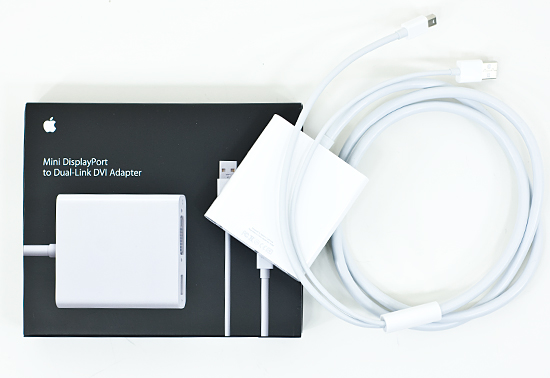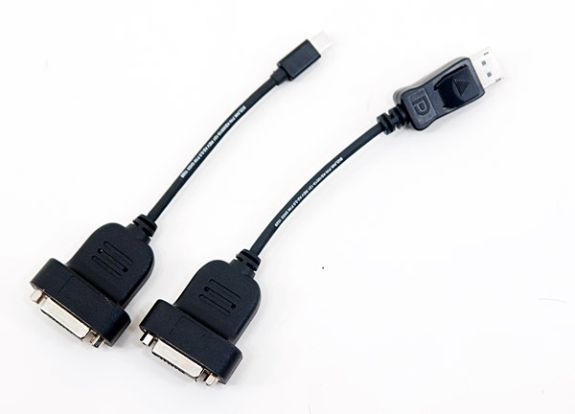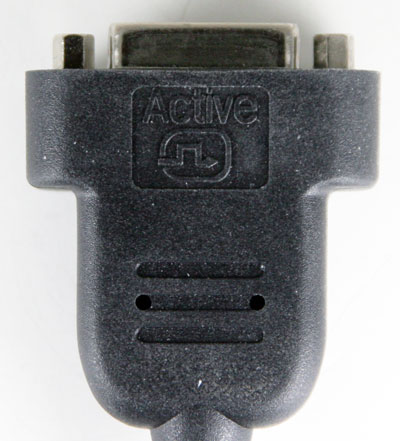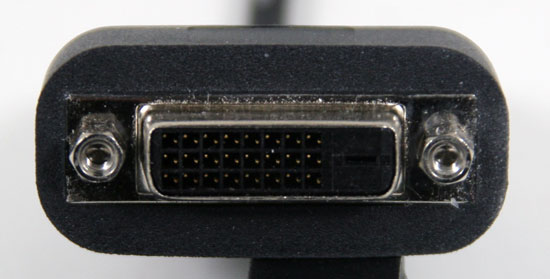DisplayPort: Active Single-Link DVI Adaptors Available Soon
by Ryan Smith on August 30, 2010 12:01 AM EST- Posted in
- GPUs
- AMD
- DisplayPort
- DVI
As we’ve covered a number of times now, AMD has been heavily pushing Eyefinity across its entire range of Radeon HD 5000 series cards. Depending on the GPU in use the 5000 series can drive up to several monitors, however because each TMDS transmitter pair necessary for driving a DVI/HDMI port requires an independent clock source, the 5000 series can only drive 2 such ports. The bulk of AMD’s flexibility is with DisplayPorts, where they only require 1 clock source between them allowing AMD to offer upwards of 6 DisplayPorts at once.
The problem for AMD is that DisplayPort adoption has been slow. DisplayPort is meant to be the successor to DVI in the PC space, affording smaller connectors and higher resolutions than DVI, while also being able to directly drive LCD panels and to be able to do all of this royalty-free. However with the boom in LCD 1080p monitors – many of which are effectively repurposed LCD TV panels – this transition has been slow to come. Even AMD’s showpiece display – the multi-monitor Samsung MD230X3/MD230X6 - only finally began shipping this month after being demoed as early as last September. Ultimately while the situation is improving, DisplayPort-capable monitors are still few in number, mostly confined to high-end monitors.

An existing Apple dual-link DVI adapter
As a result, budget Eyefinity setups have been unnecessarily expensive. The solution up until now for using 3 DVI/HDMI monitors in Eyefinity has been to use an active dual-link DVI adaptor, which converts the DisplayPort signal in to something suitable for a dual-link DVI port. The biggest issue with this is the price – an active dual-link adaptor costs around $100, as much as a Radeon HD 5670. AMD has needed a cheaper method to enable Eyefinity with DVI/HDMI monitors, and that has finally arrived in the form of the active single-link adaptor.

Active Mini-DP and DP to DVI adapters
The active single-link adaptor, as the name implies, actively converts a DisplayPort signal to a single-link DVI/HDMI signal. The difference from the dual-link adaptor comes down to power consumption and complexity: to drive a single-link DVI port, you only need half as many TMDS transmitters as is necessary for a dual-link port. With simpler hardware the active single-link adaptors can also be run on the meager amount of power supplied with a DisplayPort connection (3.3v@500mA), meaning a secondary USB plug to draw power from a USB port is no longer necessary.
In turn the reduction in complexity brings down the price of the hardware. Currently active dual-link adaptors go for around $100, but AMD is estimating the price on active single-link adaptors to be significantly cheaper at $30. The fact that it’s an active converter means it will never be cheap as simple mechanical/passive converters, but it also means that the price of a 3rd DVI/HDMI port for Eyefinity no longer costs more than some of the cards themselves.
The adaptors will come in two types: a full-sized DP-to-DVI adaptor, and a mini-DP-to-DVI adaptor. DP and mini-DP are electrically the same, so the difference comes down to best suiting the device in question: mini-DP for laptops and exotic cards like the Radeon HD 5870 Eyefinity6, and regular DP for desktop cards that have a regular port.

Active adapters are labeled with "Active" to differentiate them from passive adapters
For the adaptors we’re looking at today, they will be differentiated from passive adaptors by the addition of the word “Active” on the underside of the adaptor. It’s also worth noting that while these are single-link adaptors, the DVI port is a dual-link DVI-D port, meaning that dual-link cables will work with these adaptors in single-link mode, but DVI-I cables will not work.
In our own testing the adaptors worked as claimed. We were able to drive an 3x1920x1200 Eyefinity setup using an active adaptor, fundamental proof that the adaptor worked. Users with fairly old drivers may get a superficial "Lower setting applied" error from AMD's drivers, as they don't know what to make of a single-link adaptor.

Dual-link port for cable compatibility
Furthermore while AMD is promoting this given their heavy investment in to DisplayPort, there’s no reason that these adaptors won’t also work with NVIDIA and Intel GPUs, as these are active adaptors capable of converting any DP signal. For that matter the adaptors aren’t an AMD design (the adaptors are designed and built by 3rd parties), but for the time being it’s AMD who’s doing the heavy promotion.
Finally, availability is expected to be in early September, with an MSRP of $30. E-tailers will be selling adaptors from both traditional AMD partners and 3rd parties who specialize in adaptors, and we’d expect most if not all of these adaptors to be simple rebadges of the adaptors we received today. Also be on the lookout Radeon cards with these active adaptors bundled in, as some of AMD’s partners will be participating in the release of these adaptors.










24 Comments
View All Comments
AnAnandUser - Tuesday, August 31, 2010 - link
Directed at nexox and viperv990I have a Sony Artisan GDM-F520C, and I am curious about your thoughts of graphics card I should use to support it. I am currently using a GTX 260 Core 216 and I have a 8800 GT that I could use.
Any thoughts on analog quality?
By the way, try the HD Fury or HD Fury 2 DACs, they go from DVI to D-sub and screw directly onto the monitor. It looks pretty awesome for 1080p, I must admit. Anyways, I'd like to hear from somebody who knows about analog quality on video cards. Honestly, I would love an aftermarket DVI to analog converter from ATI or NV if it was of high quality.
AnAnandUser - Wednesday, September 1, 2010 - link
I meant GDM-C520, my mistake. Any thoughts?nubie - Tuesday, August 31, 2010 - link
I have seen a CRT with DVI.ViperV990 - Monday, August 30, 2010 - link
What took them so long?shamans33 - Monday, August 30, 2010 - link
I'm interested in information concerning displayport to vga (d-sub). Does the adapter need to be active for vga (d-sub) as well?Roland00 - Monday, August 30, 2010 - link
and in theory everyone on the market should work. The problem is that some of them just don't provide enough power from the displayport connection that sometimes you get artifacts on the screen.CrimsonFury - Monday, August 30, 2010 - link
The problem is that many users all ready have a pair of perfectly good DVI or VGA monitors and just want to add a 3rd for Eyefinity, not go out and buy a whole new monitor setup.Drag0nFire - Monday, August 30, 2010 - link
Dell now has a wide range of monitors with built in DisplayPort support. Even their cheaper models are beginning to offer displayport. And I've had great experiences with Dell monitors in the past - top notch quality and reliability.If you build an Eyefinity array out of them, you won't need any adapters!
Also, +1 for multi-resolution setups... that would be awesome.
sbradford26 - Monday, August 30, 2010 - link
I found one...http://www.amazon.com/Accell-B087B-005B-DisplayPor...
chitralsony - Wednesday, September 1, 2010 - link
This is good news. I want to start using eyefinity and i hope it will helpfull